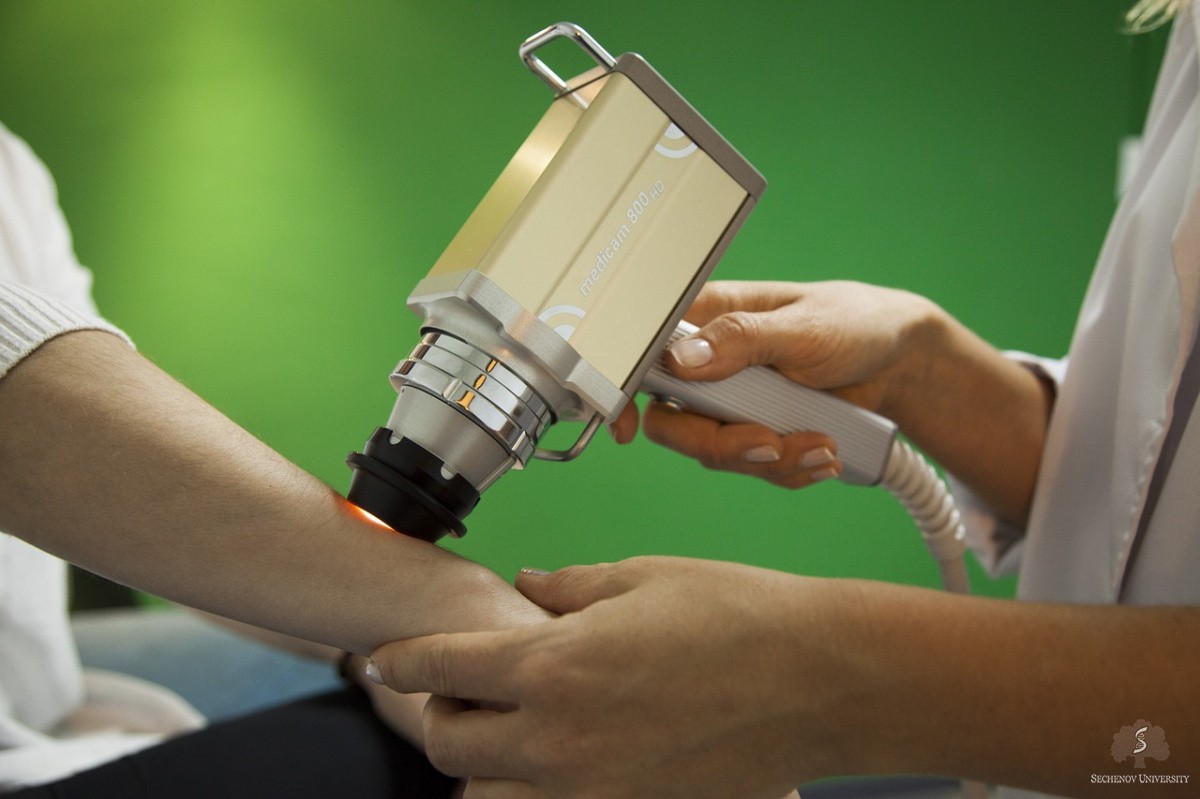-
About University
- Mission & Brand Strategy
- University Leadership
- Rector's Welcome
- History
- Regulatory Documents
- Contacts
- Staff
- International Recruitment
- Partners
Applicants- Why Sechenov University
- Degree Programmes in English
- Preparatory Training
- Non-Degree Programmes
- Transfer from other Institutions
- FAQs
12.08.2020Lipid composition of skin can indicate disease
 Analysis of the skin lipids helps identify the changes in conditions such as eczema, psoriasis, and acne. A complex approach called lipidomics can be used to do this. In the near future, this diagnostic technique should help many people suffering from skin disorders to get a clear picture of what exactly is going on and to receive better, personalised treatment.
Analysis of the skin lipids helps identify the changes in conditions such as eczema, psoriasis, and acne. A complex approach called lipidomics can be used to do this. In the near future, this diagnostic technique should help many people suffering from skin disorders to get a clear picture of what exactly is going on and to receive better, personalised treatment.
Skin diseases may affect your life in many ways. Often people do not view acne or dry skin as something serious, however, these symptoms can indicate that a person has other health problems. The skin is the largest organ of the body, responsible for perspiration and ‘breathing’ that are crucial for normal temperature regulation. Also, the skin provides a sense of touch and protects the muscles, bones, ligaments, and internal organs from the environment. The deep layer of the skin, called hypodermis or subcutaneous fatty tissue, contains a lot of lipids (fats) that play a very important role. Changes in the lipid composition can be used to diagnose a number of conditions. Sechenov University scientists have summarised the most recent advances in lipid-based diagnostics and published a review in the journal Medicinal Chemistry Communications.
Lipidomics is a discipline that investigates the lipids, their networks, and biological pathways. Like other ‘omics’ approaches, it aims to look at the whole picture, taking into account the composition and percentages of the components. For accurate measurements of the lipids in human skin, correct and representative sampling should be performed, and this presents a challenge because the procedure also needs to be non-invasive. And, of course, the sampling must not interfere with the initial composition of the tissue. Currently, tape-stripping of the skin seems the best option, but the subsequent extraction of lipids with organic solvents might cause foreign substances to appear in the sample and complicate the analysis.
A number of studies have found that the upper skin layers contain more fats, and there are considerable differences between male and female patients. Interesting patterns have been identified for various conditions — for example, eczema. This disease, also called atopic dermatitis, is manifested by red and itchy skin, has no ultimate treatment, and may come back from time to time after periods of remission. Eczema is characterised by an increased transepidermal water loss. The impaired barrier function of the skin is usually associated with changes in the lipid composition, especially ceramides. Lipidomic studies have identified certain differences in the lipid chain structure typical for eczema. Also, variations have been found in psoriasis, an autoimmune condition characterised by decreased epidermal homeostasis.
Another skin disease that affects many people is acne — an inflammatory condition caused by changes in pilosebaceous structures. The crucial factors for its development are the surface skin lipids, hormone levels, and bacterial infection. Patients with acne, according to lipidomic data, have significant deviations in the amount of free fatty acids in the skin, compared with healthy volunteers: the level of saturated acids is lower, while the opposite is true for the unsaturated free fatty acids.
The study authors hope that lipidomic analysis will help provide a deeper insight into the causes and mechanisms of the skin conditions that remain poorly understood today, despite their commonness. More representative and non-invasive skin sampling approaches would also make a great difference. The knowledge of the skin lipid composition may be used for the development of personalised therapy best suited for each patient.
The analysis was carried out by Sechenov University and the National Research Centre Institute of Immunology (Federal Medical-Biological Agency, Moscow).
Read more: Smirnov VV, Egorenkov EA, Myasnikova TN, Petukhov AE, Gegechkori VI, Sukhanova AM, Ramenskaya GV. Lipidomic analysis as a tool for identifying susceptibility to various skin diseases. Med Chem Commun (2019).
Photo credit: Pixabay 2416946Embed on website
Lipid composition of skin can indicate disease
Analysis of the skin lipids helps identify the changes in conditions such as eczema, psoriasis, and acne. A complex approach called lipidomics can be used to do this. In the near future, this diagnostic technique should help many people suffering from skin disorders to get a clear picture of what exactly is going on and to receive better, personalised treatment.
Skin diseases may affect your life in many ways. Often people do not view acne or dry skin as something serious, however, these symptoms can indicate that a person has other health problems. The skin is the largest organ of the body, responsible for perspiration and ‘breathing’ that are crucial for normal temperature regulation. Also, the skin provides a sense of touch and protects the muscles, bones, ligaments, and internal organs from the environment. The deep layer of the skin, called hypodermis or subcutaneous fatty tissue, contains a lot of lipids (fats) that play a very important role. Changes in the lipid composition can be used to diagnose a number of conditions. Sechenov University scientists have summarised the most recent advances in lipid-based diagnostics and published a review in the journal Medicinal Chemistry Communications.
Lipidomics is a discipline that investigates the lipids, their networks, and biological pathways. Like other ‘omics’ approaches, it aims to look at the whole picture, taking into account the composition and percentages of the components. For accurate measurements of the lipids in human skin, correct and representative sampling should be performed, and this presents a challenge because the procedure also needs to be non-invasive. And, of course, the sampling must not interfere with the initial composition of the tissue. Currently, tape-stripping of the skin seems the best option, but the subsequent extraction of lipids with organic solvents might cause foreign substances to appear in the sample and complicate the analysis.
A number of studies have found that the upper skin layers contain more fats, and there are considerable differences between male and female patients. Interesting patterns have been identified for various conditions — for example, eczema. This disease, also called atopic dermatitis, is manifested by red and itchy skin, has no ultimate treatment, and may come back from time to time after periods of remission. Eczema is characterised by an increased transepidermal water loss. The impaired barrier function of the skin is usually associated with changes in the lipid composition, especially ceramides. Lipidomic studies have identified certain differences in the lipid chain structure typical for eczema. Also, variations have been found in psoriasis, an autoimmune condition characterised by decreased epidermal homeostasis.
Another skin disease that affects many people is acne — an inflammatory condition caused by changes in pilosebaceous structures. The crucial factors for its development are the surface skin lipids, hormone levels, and bacterial infection. Patients with acne, according to lipidomic data, have significant deviations in the amount of free fatty acids in the skin, compared with healthy volunteers: the level of saturated acids is lower, while the opposite is true for the unsaturated free fatty acids.
The study authors hope that lipidomic analysis will help provide a deeper insight into the causes and mechanisms of the skin conditions that remain poorly understood today, despite their commonness. More representative and non-invasive skin sampling approaches would also make a great difference. The knowledge of the skin lipid composition may be used for the development of personalised therapy best suited for each patient.
The analysis was carried out by Sechenov University and the National Research Centre Institute of Immunology (Federal Medical-Biological Agency, Moscow).
Read more: Smirnov VV, Egorenkov EA, Myasnikova TN, Petukhov AE, Gegechkori VI, Sukhanova AM, Ramenskaya GV. Lipidomic analysis as a tool for identifying susceptibility to various skin diseases. Med Chem Commun (2019).
Photo credit: Pixabay 2416946



